Today our ship docked in Brisbane. Ted and I spent the entire day on a “scenic off-road drive.” This region of Australia is getting lucky; we tourists, not so much. Our guide started this gray, rainy morning by telling us that this region hasn’t had rain for over six years. To put this into perspective, he said there are children growing up who have never seen rain. That’s hard to imagine isn’t it? Because of the rain, our excursion was slightly altered, but still fun.
We drove for over an hour through Brisbane and Australia’s Gold Coast, named for its expensive oceanside real estate. Then it was time to stop at a charming little restaurant for morning tea. We had tea, coffee, and hot chocolate with warm scones, strawberry jam, and clotted (whipped) cream. Christmas decorations abounded.

Our next stop was a national park rainforest. It’s a popular destination, judging by the number of individual visitors. This rainforest was more interesting than the one we visited on Whitsunday Island. Walking with our guide gave us a huge advantage over visiting the park on our own. He was not only knowledgeable, but had sharp eyes and detected things the average visitor probably wouldn’t even know about.
Here’s a picture of our guide fearlessly entering the darkness of the dense rainforest.
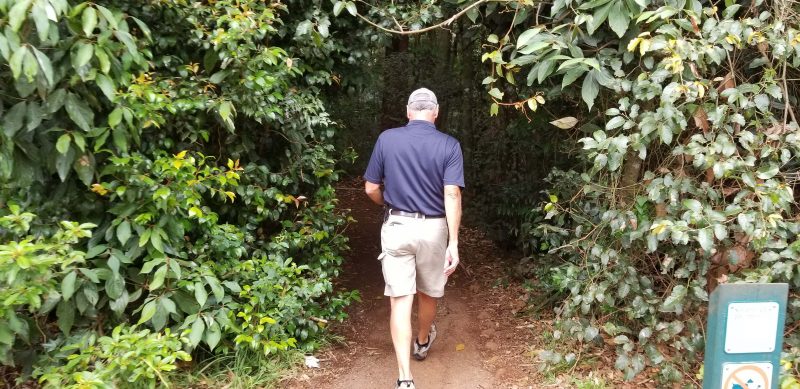
Fortunately, we followed the original trail of pioneers deep into the rainforest; otherwise, it would have been hard to find our way back.
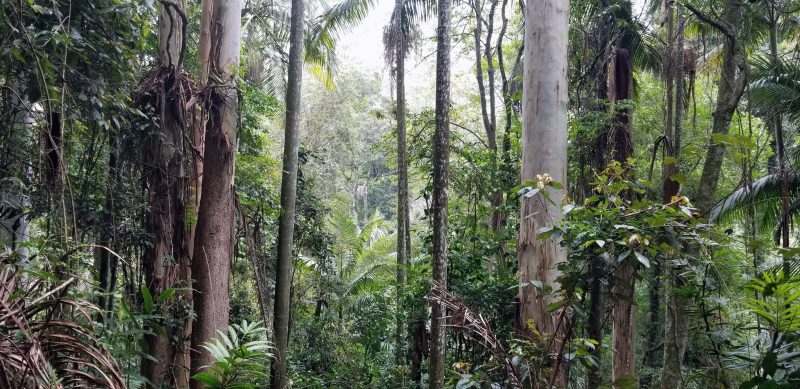
The pile of leaves behind the trees in this picture is a wild turkey nest. The male turkey builds the nest and tries to make it nice enough that a female will share it with him. If she does, she lays one of the 15-20 eggs she lays during the mating season. The male tends the egg and the chick for six months. After that, there are no bonds; the chick is on its own. Tough love in the wild, I guess. Meanwhile, the female goes around to other nests, and lays one egg in each, although sometimes she re-visits a nest and lays another single egg. She’s a loose woman who likes variety. Maybe she goes back to the guys who had the nicest nests for her. Once we knew what to look for, it was easy to spot turkey nests. We even saw a male turkey, but he didn’t hang around in our camera fields for more than a few moments.
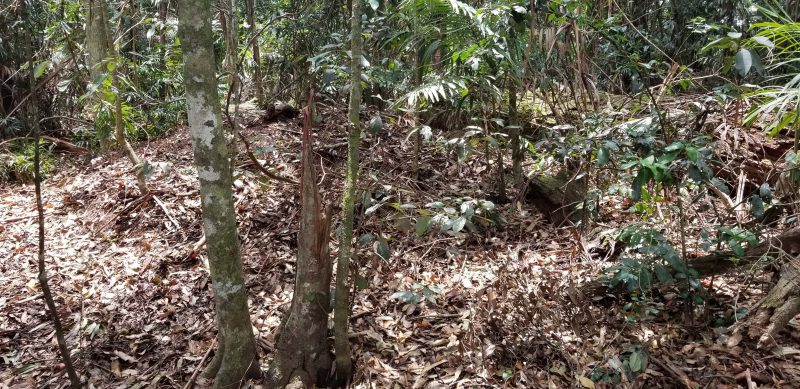
Here’s a picture of a well-camouflaged lizard we spotted as we walked down the pioneer trail. Just like the Whitsunday Island rainforest, it was downhill on the way in, uphill on the way back. Thanks to being farther south on a cloudy day, it was also cooler. Only three water bottles needed today.
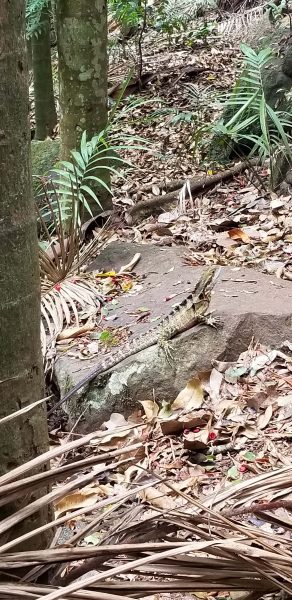
One of the most interesting animals the guide pointed out was a kind of spider that digs a hole in the dirt, makes a cover for the hole, and waits in the hole until it feels the vibration of prey walking near the opening. At that moment, the spider makes a wickedly quick grab and pulls the prey inside for dinner. Again, once you know that the faint circle on the ground is possibly a spider hole door, you can spot them. The guide used a knife to open the hole because the spider has a dangerous, although not lethal, bite.
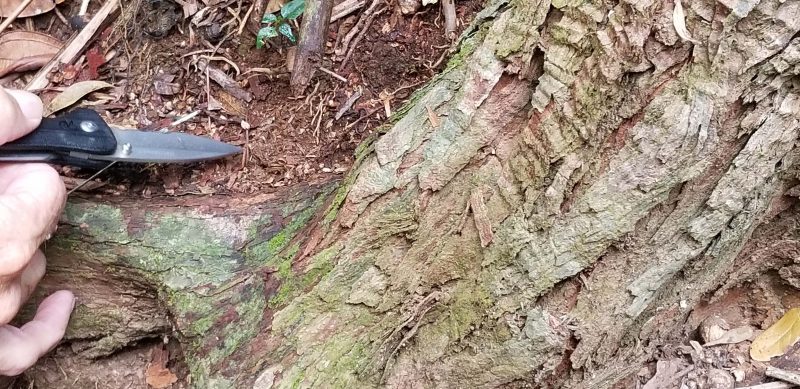
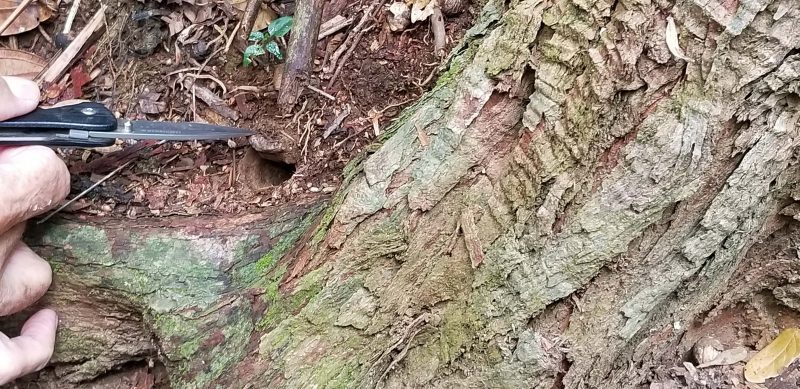
We learned some interesting things about the rainforest trees as well. Rainforest trees grow very tall, but their roots are quite shallow. To support themselves, the roots grow in a radius as large as the tree’s canopy. Some trees grow very strong roots for support.

Eucalyptus trees are so hard that if you strike them with a rock, it sounds like you’re hitting another rock. Rangers had cut and removed part of a eucalyptus trunk that had fallen across the path. Because the wood is so hard, every cut wears down the saw blade so much that a new blade is needed for each cut.
Termites like eucalyptus trees, but can’t get through the hard wood to the softer core. To reach the center, termites look for a little hole or a crack in the tree’s surface that allows them access to the softer wood. It might take nearly 200 years, but the termites devour the entire inside of the tree, eventually killing it. The tree in this picture has been hollowed out by termites, but it’s still healthy. There was a bee’s nest high in the tree. If we put our heads in the open hole, we could hear the buzzing of the bees a hundred or more feet above us. Locals have dubbed this tree the “little boy” tree.
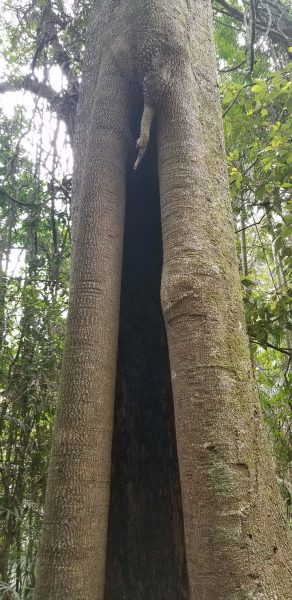
Our trail destination was a “plummeting waterfall” with an opportunity to swim in “crystalline waters of a stream in the company of wallabies or kangaroos.” That was apparently an old description of the waterfall. After six dry years, the waterfall has nearly dried up and the waters of the pool are murky. We were advised not to swim in them.
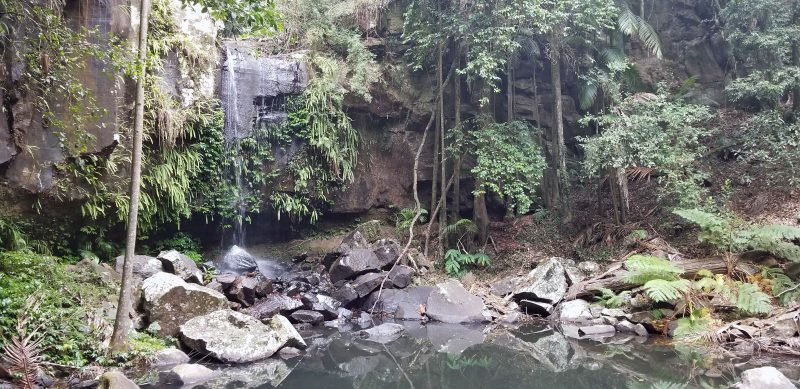
Our journey to and from lunch was the “off-road” part of this day trip. The gravel road provided us with a literally jaw-jarring ride. On the way to the back country restaurant, our guide stopped the van repeatedly to show us wildlife. He spotted a pretty face wallaby with a joey in her pouch. This is also called a whiptail wallaby because of the distance it can cover with a whip of its tail.
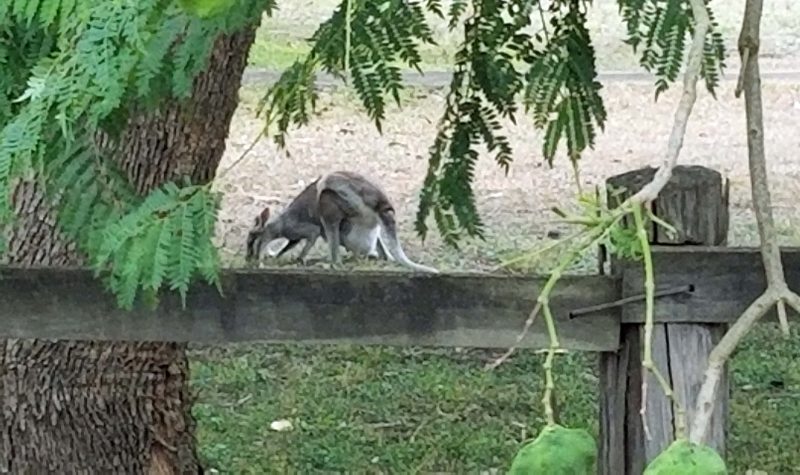
There were eastern gray kangaroos everywhere. These really count as seeing kangaroos because they weren’t caged; they were wild. Many years ago, I read that kangaroos are a suburban nuisance because of their numbers. This was farmland, so maybe it’s equivalent to having rabbits or deer on your land.
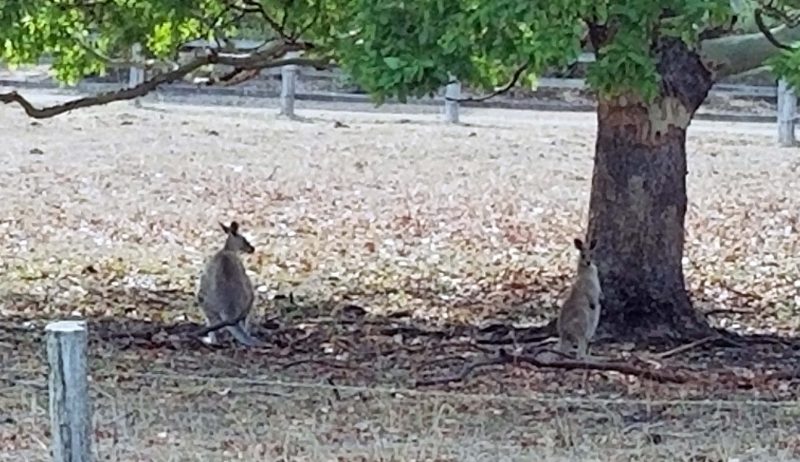
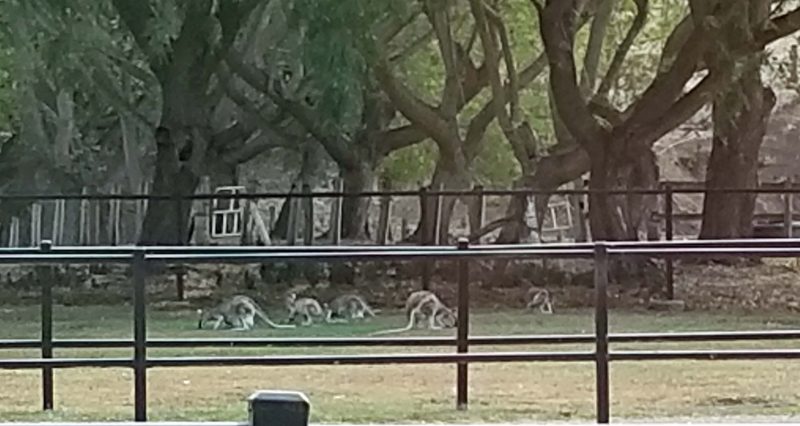
The baglike objects in these trees are flying foxes. We call them bats in the U.S.
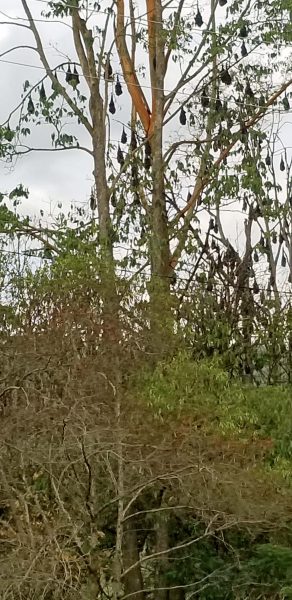
We had lunch at a back country campground. They offer true back country camping for which campers must bring everything with them, including their own water. After the camping experience, showers, toilets, and food are available at the main office site. We stayed for lunch that included barbecued beef, chicken, or fish, but we didn’t camp.


After lunch, we were treated to a boomerang lesson followed by a chance to try our boomerang-throwing skills. There are left- and right-handed versions of boomerangs, and both were available. The first picture shows the instructor; the second lets you see the thrower and the boomerang in the air (upper right quandrant); the third shows Ted. I think his boomerang went higher than my camera field because we can’t see it, but he’s obviously watching it fly.
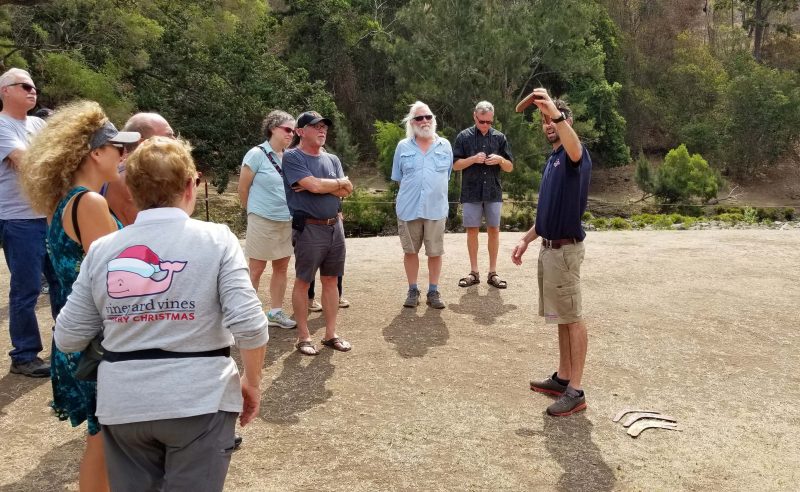
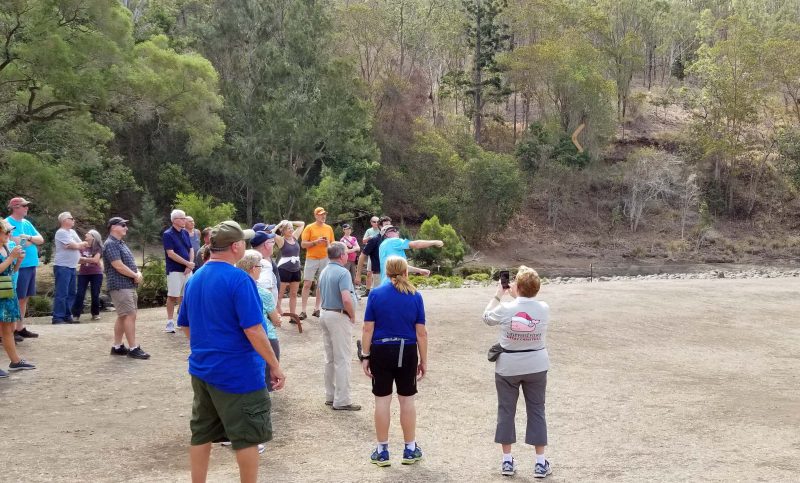

After the boomerang fun, we headed back on the jaw-jarring road and had a chance to stop at the top of Mt. Tambourine, the highest point in the area. There was supposed to be a “sweeping panorama” with a view of a distant mountain range. Due to the clouds and rain, we couldn’t see that far, but the view is still pretty good. We also crossed a pretty stream. Not surprisingly, it used to be filled to the top of the rock banks.
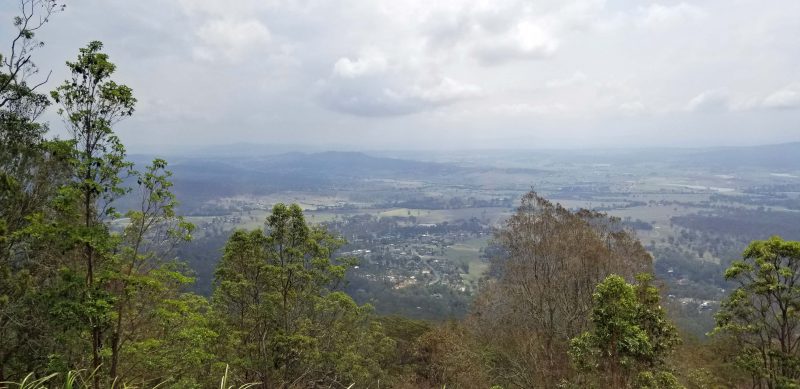
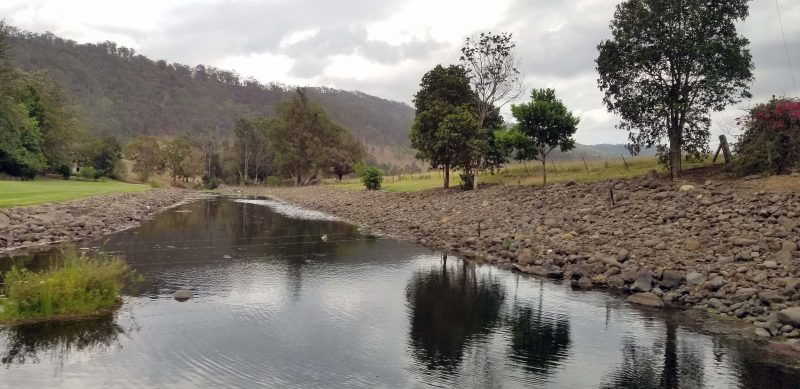
We had dinner on the ship with a special treat for Christmas Eve: baked Alaska.
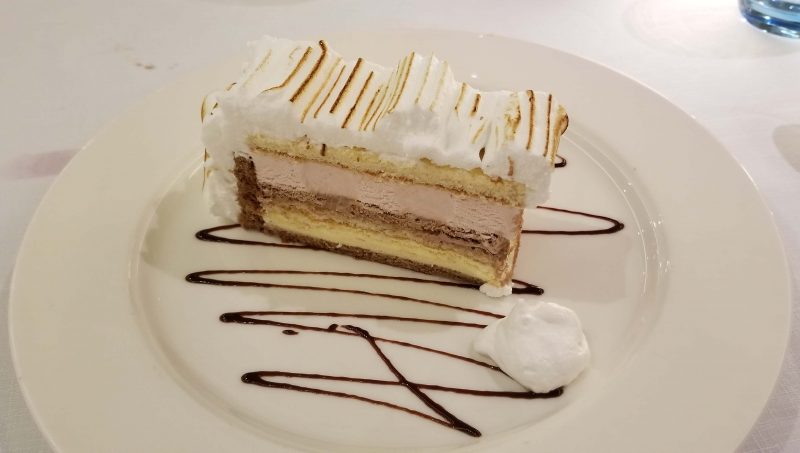
Dinner included an unexpected spectacular light show, as nearly steady, brilliant lightning flashed outside the dining room windows. The wind was fierce and the rain was heavy. At least while we were on our day trip, we had only gray skies and a single light shower.
At 10:30 p.m., there was an inter-denominational Christmas service onboard. Ted and I and about 350 other people attended it. It was very nice and, for the first time this holiday season, I feel like it’s really Christmas.
Merry Christmas, and may there be peace on earth and goodwill to all mankind.